Affiliate Marketing With Google Ads – Can You Do It?
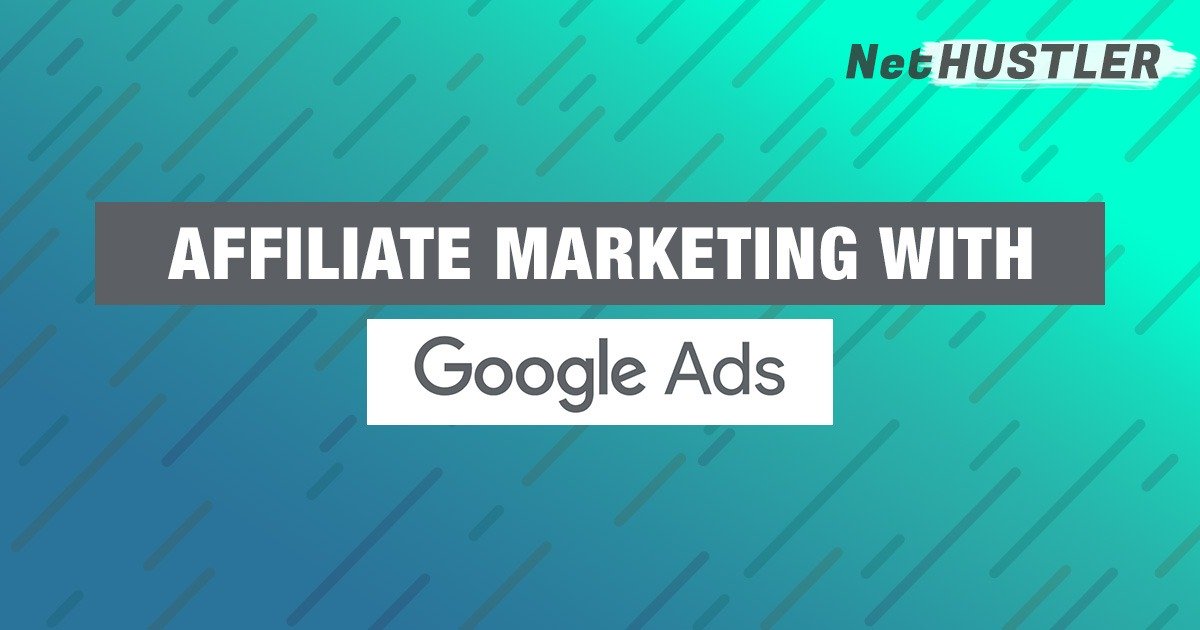
I know what you’re thinking, you have just read that title and your mind immediately went: NOPE, it’s against their rules and I can’t do it, won’t do it. Well, you’re wrong, you can actually do affiliate marketing with Google Ads, and you should try it at least once, especially if you’ve been doing affiliate marketing for a while now.
Here’s the thing, affiliate marketing with Google Ads (formerly known as AdWords) has been happening since the ad network started.
Sure it was a bit easier back in the day, regarding what you could have promoted or not and the costs were a bit cheaper. But you can still do it successfully even today.
In fact, there are affiliate marketers (or agencies) pouring millions of dollars every month on Google Ads traffic to promote other’s people products and services.
Here’s one of them:
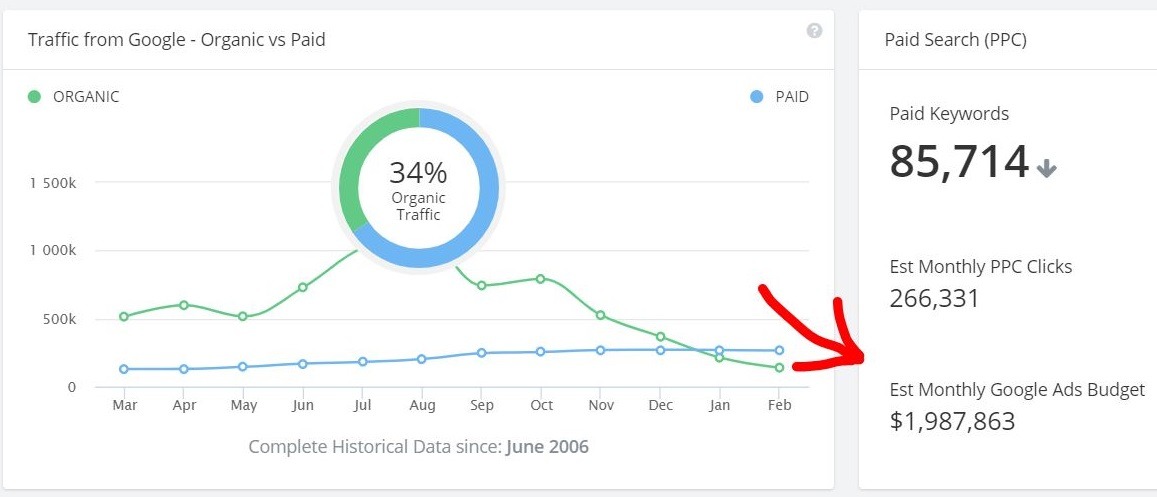
As you can see only 34% of the traffic that this website receives is organic, the rest is paid traffic from Google Ads, and they spend almost $2 million a month, promoting… *drum rolls* affiliate products.
Yes, that’s right, this website is promoting only affiliate products and services, shocking I know.
Let’s start with the big question:
Can I use Google Ads for Affiliate Marketing?
If it wasn’t obvious by now, especially after seeing the above screenshot, then yes, you can do affiliate marketing with Google Ads.
You see, over the years, it’s been “known” pretty much on every blog and popular internet marketing forum out there that you can’t promote affiliate services or products on AdWords (now Google Ads).
Somehow everyone got into their head that Google does not “like” affiliates. Every time I read that line, I start laughing.
Here are a few examples:
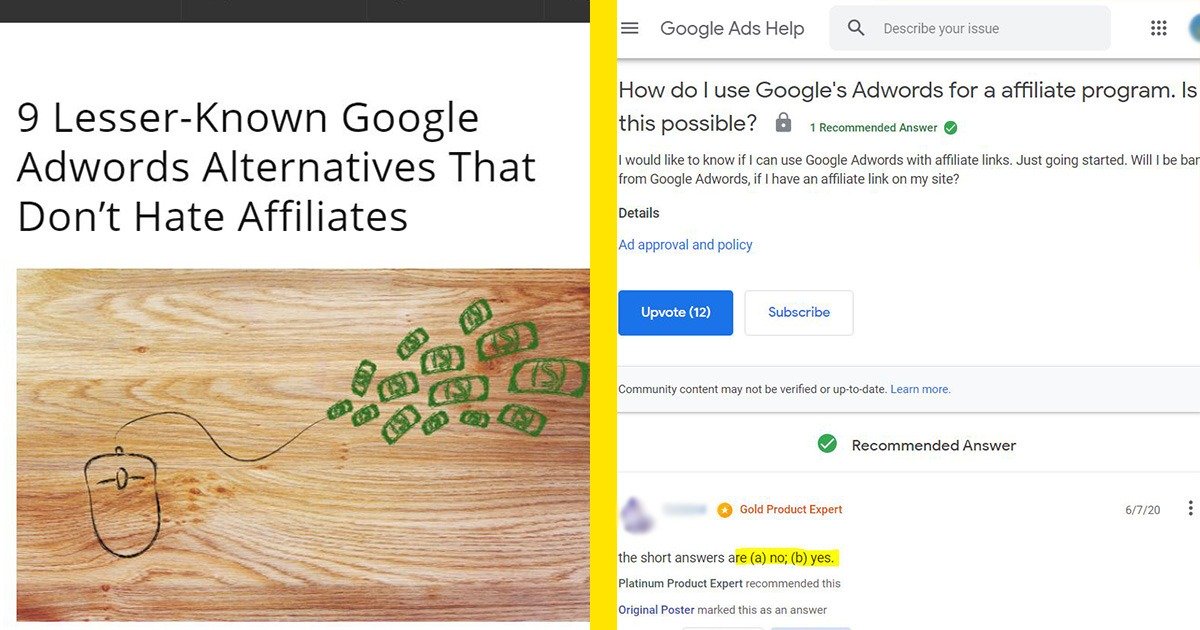
And some more + answers from more industry “experts”:
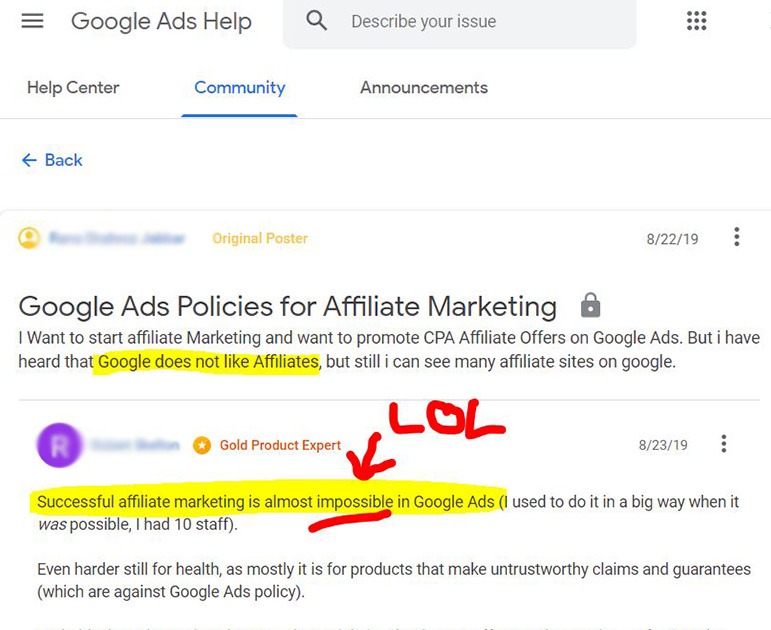
Yeah, right…
If it was so impossible to do it then we wouldn’t have sites that are spending from tens of thousands of dollars to a few million monthly in Google Ads to send traffic to pages with affiliate products on them:
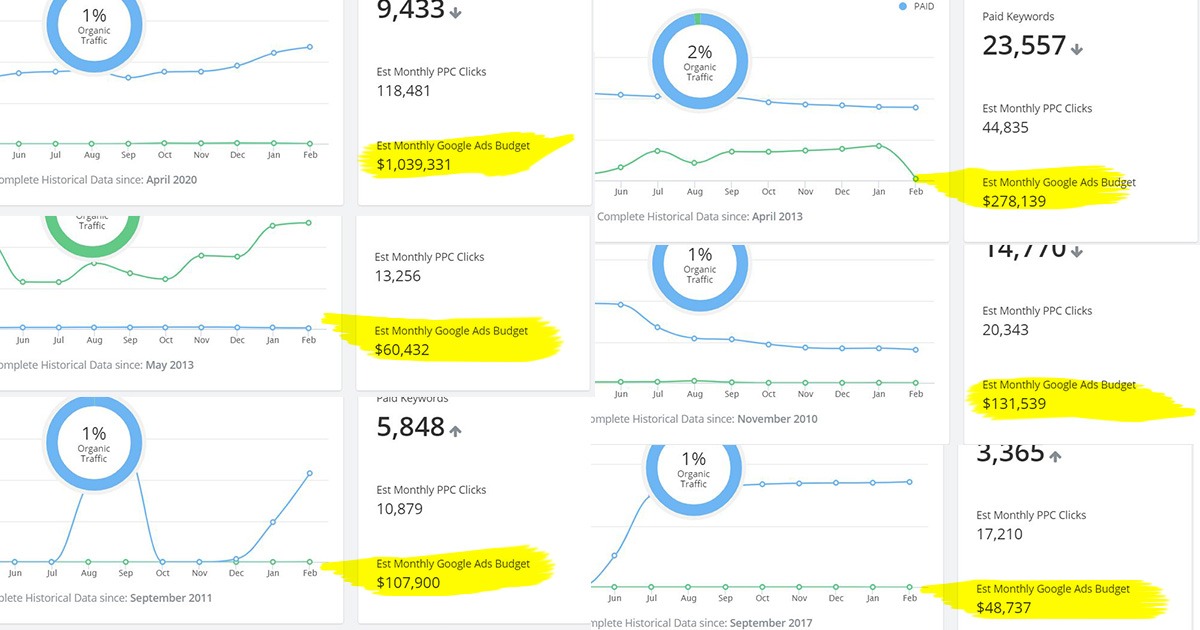
If they were doing something that’s against Google Ads rules, do you think they would be able to spend these amounts of money every month?
Anyway… this kinda turned into a rant, but that’s what happens when people don’t do the research and they just spew out things just for the sake of it.
So, yes it’s possible to do affiliate marketing with Google Ads, but you have to play nice and follow the rules. You can’t just copy/paste a URL from your affiliate network and just run an ad like you would with other ad networks out there.
NOPE…
Like, I said, you have to do some research first if you don’t want to get your account suspended.
How to promote affiliate products on Google Ads
Alright, so how do you actually go and promote affiliate products with Google Ads? Well… it’s not that easy to pull off, but it’s for sure not impossible like some people out there think it is.
The guidelines below are not GUARANTEED to not get your account suspended, it depends on how you implement things, what niches you choose, what ads you create, etc.
It’s more of a guide to steer you in the right direction, you will still have to do your own research just to make sure you’re complying with Google’s rules.
1. Don’t direct link
I know I’ve talked about how to do affiliate marketing without a website in the past, but it’s not something that I recommend overall and I certainly DO NOT RECOMMEND you to try and promote affiliate products on Google Ads without a website.
2. Create a website
You want to have a website, like I’ve said above, and never a direct link. Not just any website, no… you want to create a high-QUALITY website.
I’m not talking about design here, by the way, sure the design and the UI elements and accessibility is important, but I’m talking about the content on your website.
It all starts with your content and making sure that you follow Google’s webmaster guidelines and policies, along with their rules for ads.
You need to make sure that you have enough content, first of all, that’s dedicated to that product that you’re promoting, either on your landing page or overall across your whole website.
There are affiliate marketers that create just these websites that are basically a bridge page (how Google calls it) out there, and they try to run ads to them and then they discover that their account has been banned.
Remember earlier how I laughed about the people that thought Google “hates” affiliates? Well, they don’t hate affiliates, they DISLIKE affiliates that use bridge pages and overall websites and products that add no value or have no quality to the user.
Google cares the most about the user (whether it’s paid traffic or free organic traffic), that’s why non-unique articles that offer no value to people will never rank higher than quality, and original articles written by established websites with authority.
So it’s the same with Google Ads, you don’t want to have filler or bridge pages that just have a few words on them and then a big button that redirects users to the affiliate product when clicked.
Most marketers will just tell you to build a landing page “bro”, and you should be good to go.
Nope. Don’t do that, sure it might work, but more likely than not a single landing page on your whole domain won’t be something that can keep your account in good standing for too long.
Instead, you want to build a brand, an established website, with authority, and unique and amazing content that brings a lot of value to the users.
Learn how to create a website or start a blog if you don’t know how yet, but take the time writing good content on it, and create different pages and add affiliate products in such a way that are not the sole focus of your page.
Is it hard? Yeah, is it impossible? Again, no. You don’t need hundreds and thousands of pages, but you know… do some effort if you want this to work for you long-term, it’s not just about Google Ads.
Another option would be to not have any affiliate products and services on your page and just have an opt-in form, asking users to sign up and after that, you can send them to the offer. I don’t recommend you to do that, because most of you will go out there and sign up with Google Ads and just send traffic to a squeeze page and then get banned.
You can collect leads with Google Ads, but guess what, you still need to have a relevant and high-quality website beyond your simple squeeze page.
If all your website’s content and value are based on just that one squeeze page to collect leads, or how Google put’s it “information harvesting”, then your Google Ads account won’t survive for long.

Every user needs to see exactly why they are signing up to your list and what they’re going to receive. It’s also good to have contact information along with a more in-depth description of what it is that you’re actually offering on your page.
You should treat this as a real business with multiple possibilities of expansion, growth, and revenue streams.
So, TL;DR: High-quality website with great and unique content that doesn’t promote junk products and doesn’t just use those products as the sole focus of the landing page will make a big difference in your affiliate marketing with Google Ads journey.
Make sense?
Of course, it does…because having an established website with a lot of valuable content will also help bring you some organic free traffic once it starts ranking, plus it will help improve your ad quality score which in turn has the chance to lower your CPC.
So, let’s move on.
3. Choose the right affiliate products
Like I said before, the affiliate products and services that you’re going to promote need to be of high quality. So don’t think of junk CPA offers with email submits, paid surveys, dating, magic pills, or anything of that nature.
First of all, don’t promote products that are basically YMYL (your money or your life) offers, and pretty much anything else that is shady or affiliate marketing scams.
Some of these include:
- Get rich quick / make money online products
- How to lose weight fast
- Skincare products
- Anything illegal (obviously)
- … and a bunch of other bad stuff. (read Google Ads rules and website guidelines thoroughly)
Find good and respectable products and services that you can become an affiliate and promote, think big companies and brands that have been around for a while now.
These companies aren’t likely to go away anytime soon or get involved in shady stuff like some of the affiliates offers that you will get in most CPA networks out there.
Think real products and services that people can use to better their lives every day, and even think outside affiliate networks, and go straight to the brands.
You could also step away from regular affiliate networks that you know of (you know those with dating CPA, forex, Nutra, etc offers) and try to join more “normal” networks.
Some examples: Amazon Associates, Commission Junction, and ShareASale. You will find a much better selection of products that have a higher quality and customer service than the ones you will find in other affiliate networks that we marketers like to use sometimes.
4. Don’t write any misguided claims
I’ve touched on this for a bit with the YMYL affiliate products. You want to avoid using superlatives and misguiding claims on your landing page and in your ads.
No “Learn how to become a zillionaire in 3 weeks” or “Learn how to lose 34KG or pounds or whatever in 7 days”. For one, it’s bad in general to promote those offers since you’re basically lying to the customers, and two, you will most certainly get your Google Ads account suspended.
Don’t claim things that the product or service or whatever can’t deliver. Making up stuff just to get clicks, leads or sales is not a good approach, not only with Google Ads but with affiliate marketing in general.
Why?
Well, because the customers won’t be happy with what they receive, and guess what they’re going to do? Ask for a refund. So what will happen after that? Well, the affiliate network or company will refund them and then they will take out money from your account to pay for the refund.
Oh… and bonus points, you might get removed from promoting the offer or even get banned from the affiliate network too, how “awesome” is that?
No affiliate vendor wants a high refund rate, because that comes with a lot of charge-backs and fees that they will have to incur. But if a product you’re thinking of promoting does have a high refund rate, then it’s a clear indication to stay away from it.
Most affiliate networks will have a way of showing you how the products are performing, either by directly showing the refund rate or by other metrics such as network performance and EPC value for other affiliates.
In conclusion, if you’re not promoting trash products that make absurd claims, you should be good, but as always check the rules.
5. Read Google Ads Policies and Website Guidelines
Speaking of rules, go ahead and read them all. Yes, I mean all. Check out all the policies for Google Ads, and their webmaster guidelines, along with landing page experience.
But you should also check out the rules of your affiliate network and the product that you’re promoting. Some products will not allow affiliate s to run paid search traffic to their products, so you want to make sure that’s not going to happen.
Yes, reading rules and policies and terms are boring
I get that, we all kinda just click on “Agree” on everything to make it go away… we’re all guilty of that, right?….right? I hope I’m not alone on that one.
However…
When it comes to Google Ads, and advertising in general, you want to make sure that you read and understand the ad network’s rules and terms before you start promoting on them.
Every ad network has some kind of rules that you will need to be aware of, some are more lenient (like pop and push ad networks) others are more strict like Google Ads, Facebook Ads, and Microsoft Advertising.
So to avoid having your ad account suspended, go ahead and read through all the pages and get yourself better familiarized with how Google Ads works and what their guidelines are.
There’s a lot of stuff on their policy pages that I simply cannot explain in this article, otherwise, it will make it even longer than it is right now, so when you have the time and before you start advertising with them, go ahead and read them, it shouldn’t take you more than 30-60 minutes anyway (if that).
6. Check your tracking & affiliate links
I’ve always said that when doing affiliate marketing you should always use a tracker and track everything that’s going on especially when you’re paying for traffic.
But when it comes to Google Ads, you want to be careful with how you track your affiliate products and what type of links for the affiliate product you have on your page.
First of all, you don’t want to use affiliate smart links or any other affiliate link with redirects.
You don’t want to use shady scripts or tools that will “cloak” your links, and again avoid smart redirects. You can get your Google Ads account suspended for doing that.
You have been WARNED.
So how can you track your affiliate campaigns then, if you can’t use a regular affiliate tracking software?
Well, you can still track how you’re campaigns are doing by using Google’s UTM tags, and without affiliate links that contain redirects.
You want to use direct affiliate deep links that when clicked will send the user straight to the correct page, without going through additional loops and domain redirects.
So here’s an example: YourSite.com = > affiliateproductoffer.com/sign-up
Usually, affiliate links will have a bunch of other domain redirects for internal tracking something like link1.com > link2.com >link3.com > affiliateproductoffer.com
Avoid all of that by using direct affiliate links that send users straight to the product page.
You want the whole process to be as smooth as possible without ALTERING the links in any way. Like I said use UTM tags at most in your affiliate links and make sure the links don’t redirect again.
So don’t use any tracking or cloaking software. Most affiliate marketing websites that you will see in Google don’t use outside trackers or redirects, they use internal scripts along with UTM tags and manually adding conversions to their Google Ads account to make sure that they are compliant.
Yes, I’ve repeated myself a few times, but this step is crucial for you to understand if you don’t want to risk losing your Google Ads account.
Sure, some might get away with using a tracker like Clickmagick, which does a good job, at tracking your affiliate links, and they even say that they are compliant with Google Ads, but still, I personally wouldn’t risk using it.
Ask your affiliate manager for direct links to the affiliate product’s page, any respectable affiliate network out there will have no problem with this and will have ways to comply with Google Ads direct link requirements.
Better yet, don’t even use affiliate networks.
Go straight to the service or product, sign up as an affiliate with their system and all their links won’t have additional redirects anymore, plus the quality and the rates are way better.
If you get your account suspended for breaking the “Circumventing Systems Policy”, it’s because you didn’t use proper links and instead you used redirects, smart redirects (based on GEO or device), affiliate network redirects, cloaked links, tracker links, and all that stuff.
Just use regular UTM tags and manually add conversions and you should be fine.
7. Avoid bidding on brand terms
Every affiliate program that you join will have its own set of rules like I’ve explained above. Most of the time the important one is to not bid on the brand’s terms on PPC ads.
This means that if the brand that you’re promoting is called XYZ then you’re not allowed to use XYZ anywhere inside your ad copy (title, description, URL) and sometimes you won’t even be allowed to use it as a keyword.
So make sure that you read all the terms of the affiliate program before you start promoting it, regardless if you do it with Google Ads or any other ad network out there.
Ignoring that rule will get you kicked off from the offer, your commissions will be voided and you might even get banned from the affiliate network. So yeah, not good.
Examples of Affiliate Marketing Websites on Google Ads
I’m going to show you now some examples of affiliate marketing being done on Google Ads right now along with some PPC ads.
This way, you will better understand on how your website should look like and the level of quality that it needs to have if you want to make this a successful business model.
Let’s start with some ad copies, and see if it’s really that impossible to run affiliate marketing on Google Ads:

As you can see in our first example, we have 2 out of the 3 top Google Ads, as affiliate marketing websites. Hmm 🤔, and they also promote Amazon Associate products, which some also think’s not ok to do on PPC.
It’s weird how that works out for these sites that are spending thousands of dollars or more each month on Google Ads. I wonder if there’s anything that they do differently compared to the millions of other affiliate marketers out there.
Oh…right.
They absolutely do have a totally different approach to affiliate marketing than the rest. If you go check out their sites you will see that they have a lot of content that provides great value to the user or customer to be.
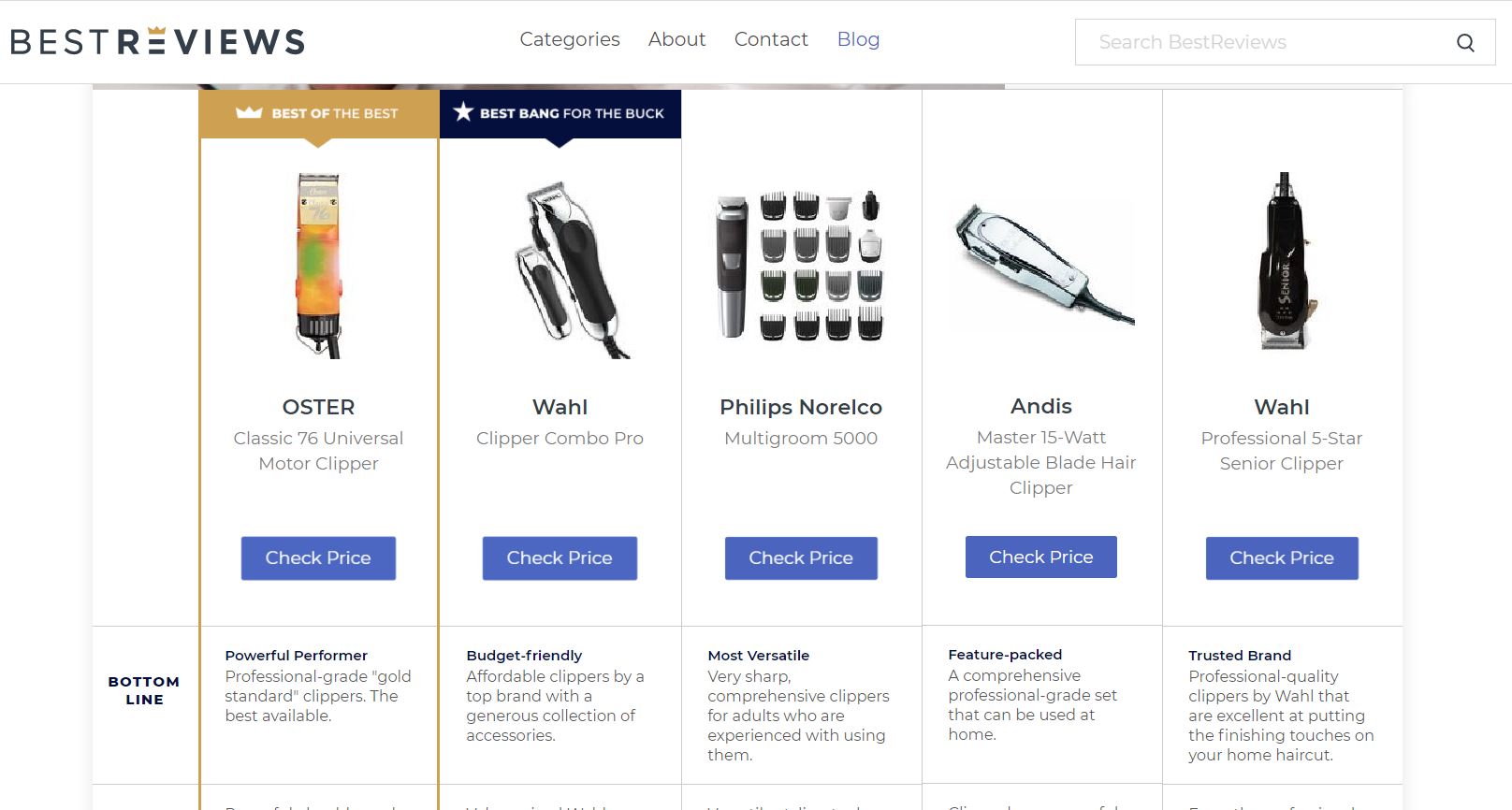
From product specifications to price ranges, and a lot of good quality content in between, and not just on the landing page, all the pages from their websites are amazing.
They don’t just use a bridge page to send customers away as quickly as possible, and they don’t have one lousy squeeze page trying to get an email subscriber and then the rest of the site sits empty.
No. They have hundreds or even thousands of pages dedicated to products, reviews, how-to’s, and guides. That’s the only sustainable way to do affiliate marketing anyway, and I mean that in general not just with Google Ads.
I’ve learned that the hard way over the years of spending money on buying traffic redirecting it directly to others without even trying to build my own brands or audience or email list.
Anyway… let’s see more examples, shall we?
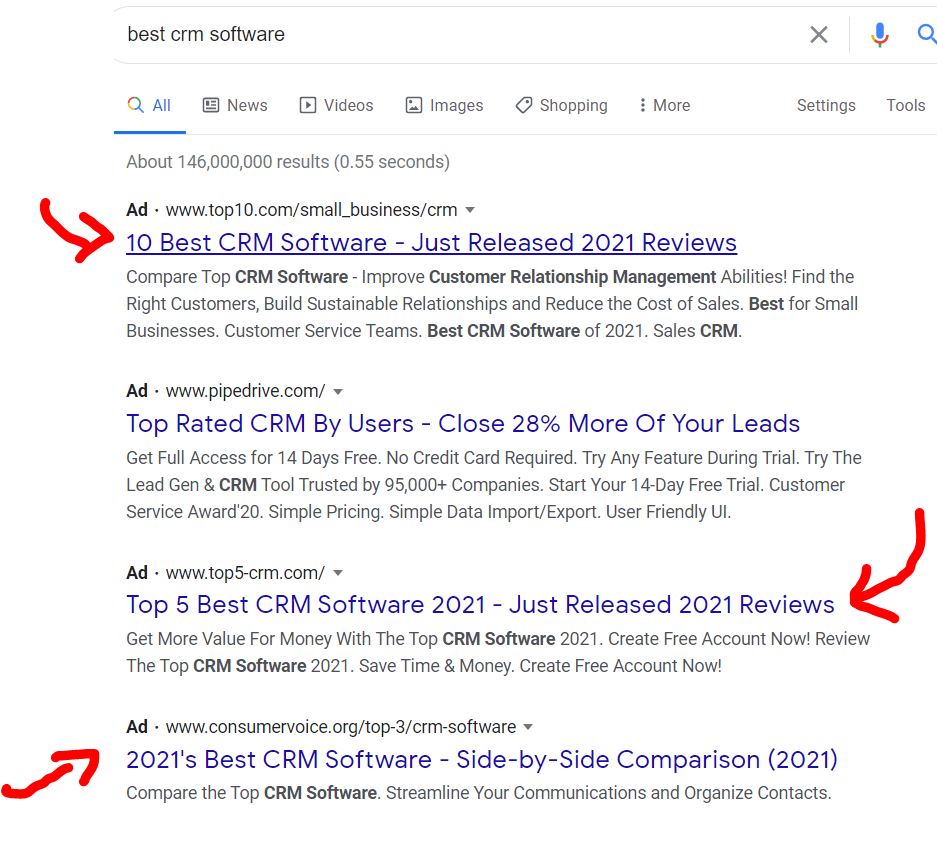
Amazingly, 3 out of the 4 top ads are for affiliate websites. Wow, those experts sure know what’s up.
These are not bridge pages either, and they don’t advertise since yesterday. Some of these sites are spending MILLIONS per month for YEARS now.
Do you think that if they did anything against Google Ads policies that they would still be standing and running traffic today? I don’t think so.
If you take a look for example at Top10.com’s landing page you will see something like this:
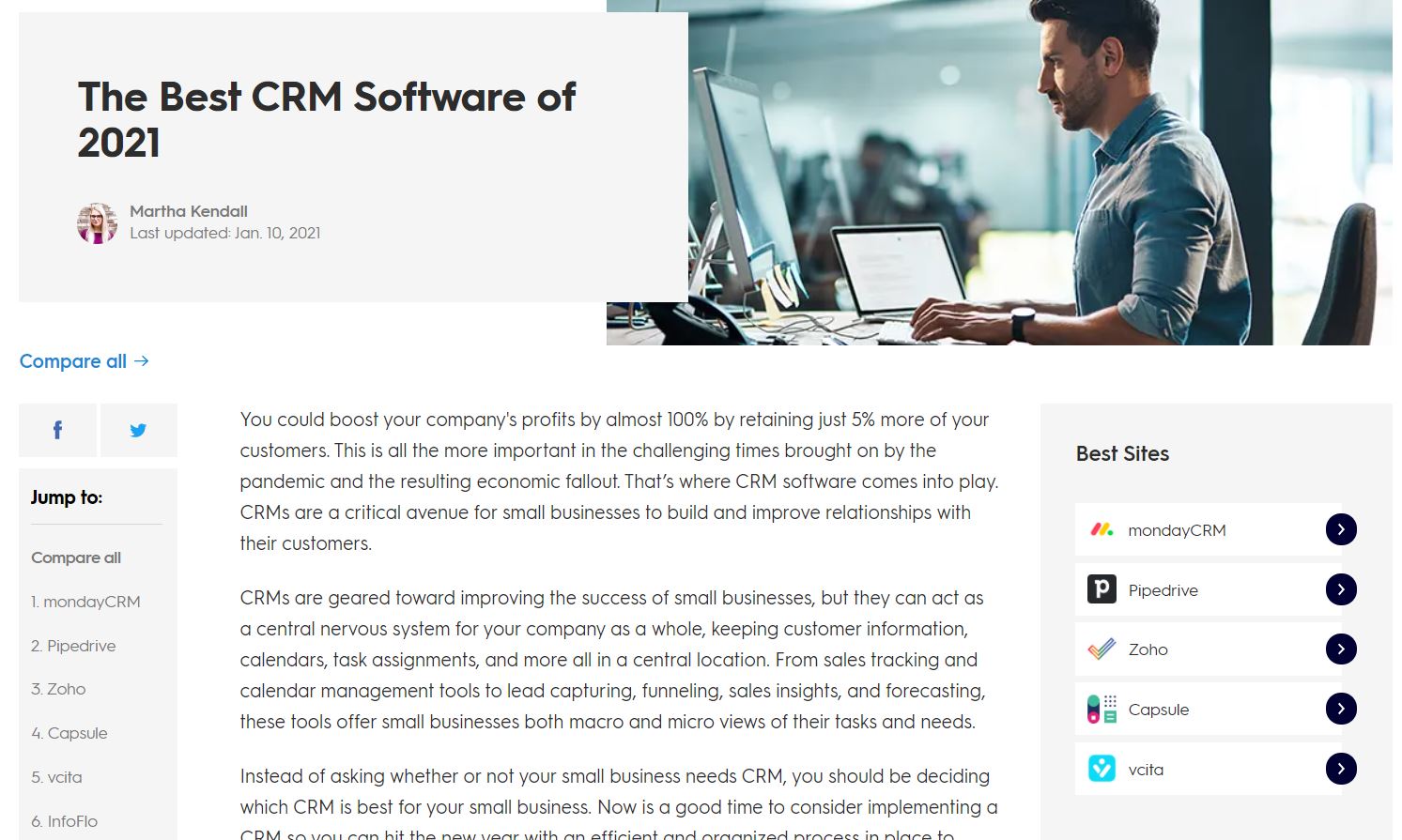
Notice how they have a clean-looking website with a lot of value for the users to easily identify and compare multiple products?
Also if you scroll down on that page, you will see thousands of words written on the topic of CRM and how they have rated the products. With in-depth comparisons and tests.
So it’s not as putting up a simple landing page done by someone on Fiverr and then put a big BUY button on it.
Ok, one more example:
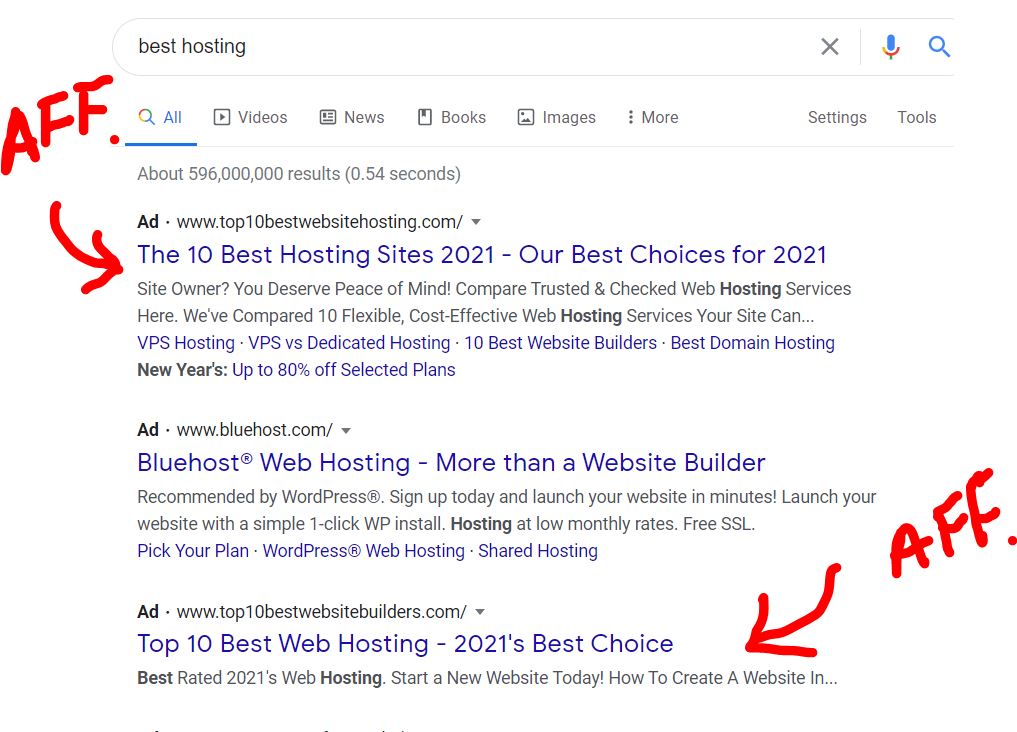
Alright, so in our latest example as you can see we have 3 more ads, two of which are websites that promote affiliate products.
So as you can see, there are quite a lot of unique and creative ways of making a good quality website and also earning money while promoting GOOD affiliate products and services with Google Ads.
Most of these sites in fact only get PPC traffic and most of the time they have a sub 5% organic free traffic to their websites, and yet they somehow thrive. Even with the not-so-cheap clicks of Google Ads when it comes to keywords like “CRM software” or “Website hosting”.
So what does this all mean for you?
Can you do it too? Maybe. It depends on how hard you want to work and how good your website quality will be. It depends if you want to make a quick dollar or if you want to build a sustainable business model.
It also depends on the fact that you need to adhere to Google Ads policies and webmaster guidelines completely, and always be on the lookout for any new changes that might happen to their policies.
Things will always change, especially in the digital space, and Google Ads in particular is an evolving system that updates itself constantly to get better at detecting fraud, bad ads, weak landing pages, etc.
So… yes you can do it…
But…
This doesn’t mean that you will go out there and copy these exact niches and create the same sites. Remember Google wants authenticity and for you to provide value to the user.
Plus, if you’re site and offers are identical to the other ones, then you might even lose money because you have nothing new to tell a customer, and they can just leave the site and browse for more info somewhere else.
It happens more than you think, go check out Alexa.com rankings on some domains and you will see that after a user leaves the page they will more than likely go back to Google to search for more or other answers.
So, can you get inspired by these sites and come up with your own ideas, content, website, and ad copies? YES.
Can you just copy everything to get rich quickly? NO 🤦♂️ (are you even reading what I’ve been writing for the past few hours on this article? just don’t do it, simple as that.)
P.S: Also don’t go on Google search and click on ads to go see what websites are doing affiliate marketing:
- That’s totally not a cool way of doing things
- Every time you click aimlessly with no real intent on those ads, advertisers will lose money
- You wouldn’t want the same happening to you now, would you?
- Just copy/paste the URL directly into your search bar and then look at the page that way or search in Google: site://website.com + “term” and you will get to see all the pages (if they are indexable)
P.P.S: For the actual advertisers: No ads were clicked on during the research of this article… (but I do hope you’re using a click fraud solution like Clickcease)
The Pros & Cons of Google Ads
These pros and cons are more specifically about doing affiliate marketing on Google Ads and not for other types of websites that can be advertised on Google (like e-commerce, your own service, and products, etc)
So here they are:
The Pros of Google Ads for Affiliates
Best quality of traffic – It simply is, hands down. If people are searching for something it means that they want to buy it. It’s not social traffic where people are not in the mood to shop and they just want to look at cat videos.
Huge volume and reach possibilities – Nobody can match Google Ads traffic volume, and their immense reach to target almost everybody that is searching for things online from anywhere in the world.
No minimum deposit – This one is amazing especially since so many ad networks are asking for minimum deposits these days.
Instant results – You don’t need to wait a whole lot of time for your ads to go live (if approved), it usually happens in a matter of minutes but can also take a few hours (especially during these times when everyone is kinda working at capacity)
Not that complicated – Surprisingly, for an ad platform this big, it’s not really that complicated to create an ad and get up and running in minutes. It takes less time to create an ad on Google than on Facebook or Instagram or any pop ad network out there (at least for me, your experience may vary)
Easy to scale up – With some ad networks scaling up your campaigns can be difficult, not with Google. They have so much volume and so many different properties that it makes it very easy for you to scale up. You can put ads on YouTube, Gmail, Android Apps, Display Network (millions of websites that are using AdSense). The possibilities are almost endless.
The Cons of Google Ads for Affiliates
Can be expensive – Depending on the niche, you might have to pay a higher CPC than on other ad networks. So examples like the above with web hosting and CRM software can have an average CPC of $5. But you can always get a smaller CPC depending on the GEO and the landing page score, plus you shouldn’t go after high CPC niches anyway especially if you’re just starting out. So get creative open up the Google Ads planner and see some forecasts with prices for certain keywords.
*HINT* You can even get under $0.10 CPCs if you don’t focus on search engine ads, I sometimes get lower CPCs when advertising on the Google Ads Display Network than on numerous banner and native ad companies out there. 😉 But don’t tell this to too many people, let them go to Taboola or Facebook lol.
Easy to get your account suspended – Especially if you’re doing affiliate marketing, and you don’t follow their policies carefully. It’s very easy to misplace an affiliate link that had a redirect in it, and your whole account can get suspended for breaking their circumventing the system policy.
Takes time to learn – While it’s easy to get up and running with Google Ads, you will have a steep learning curve if you want to optimize your ads to get the lowest CPC that you can and keeping your CTR and conversion rates up. Not to mention staying compliant with the guidelines and policies.
Your Website Needs To Be Amazing – Literally, like I’ve mentioned so many times in this article, your website and landing page needs to be top-notch. A simple landing page with a few affiliate links on it won’t fly with Google. So make sure you build and establish a brand first, and think of providing value to the users, and then add affiliate links and try advertising on Google Ads.
Clicks don’t mean conversions – Even if the traffic quality of Google Ads is one of the best in the world (if not the best), that still doesn’t mean that you will get conversions every time someone will click on your ads. That can ruin your budget planning especially if you don’t have too much money to start and test the waters.
Click fraud does happen – As I said previously, don’t just go ahead and click on Google Ads at random, that will bring high costs to the advertisers, and that might also happen to you. Unfortunately, sometimes this is done on purpose by competitors that are bidding for the same keywords so that they can ruin their ad budget and stop advertising. There are some solutions to this, but that’s for a whole other post.
So yeah, there are a few cons equally proportionate to the pros, it’s up to you to weigh them all and see if it makes sense to do it.
Affiliate marketing with Google Ads step-by-step guide:
So, by now you’re probably wondering what’s the best and easiest way to get started with affiliate marketing on Google Ads, where here’s a short step-by-step guide:
- Decide on the niche (if you don’t have one already)
- Create a high-quality website – And a landing page that’s compliant with Google Ads landing page experience Policy.
- Open a Google Ads account – Use my Google Ads partner link to get your ad spend matched by Google when you sign up.
- Do keywords research – Don’t bid too broad, use negative keywords, and don’t bid on brand terms.
- Create the ads – Keep the ads relevant to your landing page and what it says on it, don’t make stuff up or use scarcity tactics.
- Use normal UTM tags for tracking – Don’t use affiliate tracking software, and don’t use affiliate links on your site that have redirects in them or if they are cloaked.
- Optimize the ads – Try to get a better landing page score, and higher ad CTRs, this will in turn decrease your ad costs.
Yes, it’s a quick summary of the whole process, but it will be too long to actually go through all the details in this article. I’m going to work on a more in-depth video or guide about this so subscribe and stay tuned.
Affiliate Marketing with Google Ads: Promo Offer & Final Thoughts
Finally, if you’ve read everything up until this point, it pretty much means that you’re interested in trying out affiliate marketing with Google Ads.
Sure, it might seem like a lot of hard work is involved in trying to run affiliate marketing on Google Ads, and it’s true, you will have to put some effort into it.
You can still do and run your fun CPA offers on various other ad networks out there, from time to time (that’s what I do when I’m bored).
But none of those ad networks will ever compare to Google Ads in terms of volume and user purchasing power.
Google Ads is the largest ad network out there by far, followed by Facebook Ads. So it only makes sense to give it a try at least one time.
You don’t even need super high budgets to get started with Google Ads, I know that’s usually what most people think of when they hear about Google ads.
But hey… you know me, I’m a fan of cheap traffic sources, and I’m telling you that you can still get cheap clicks from Google Ads in 2022, and start affiliate marketing on a budget of $100.
Sure, you might not get a $0.01 CPC, but you can get a decent amount of traffic with CPCs ranging between $0.05-$0.10, and that’s in top GEOs like the US and Canada.
Check out how to get Google Ads Promo Codes.
FAQ:
By not promoting junk products and by having a good quality website that offers value for the user. And making sure that your site stays compliant all the time with Google Ads policies.
Nowhere in their rules and policies does Google Ads specify that they don’t allow affiliate links. They do however dislike bridge pages, poorly created websites with no unique content or value for the customers, that promote junk affiliate products with misguided claims.
Yes, again, provided that your website is amazing and has actual value for the website visitors, and you don’t do direct linking. Simply copy/pasting a product image with a few details and a link to Amazon won’t cut it.
The same as I’ve explained before if the products are of bad quality don’t promote them. Keep in mind that some if not most of the affiliate products on Clickbank are leaning on the YMYL (Your money or your life) kind of landing page and product so be careful which one you choose to promote. In general, I would not recommend you to promote Clickbank products on Google Ads, promote those products with other ad networks, it’s not worth the risk.

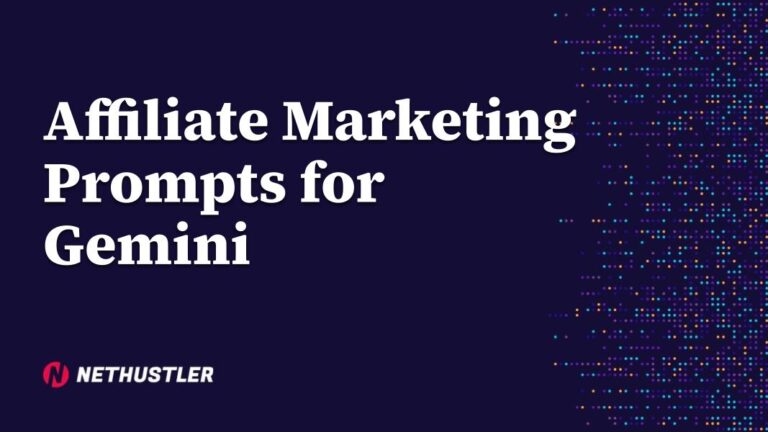
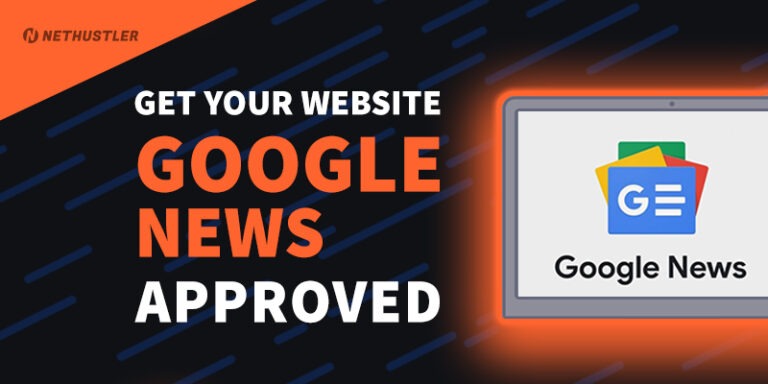

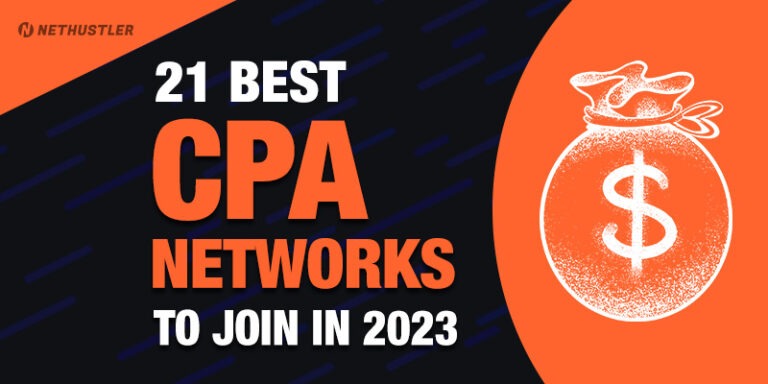
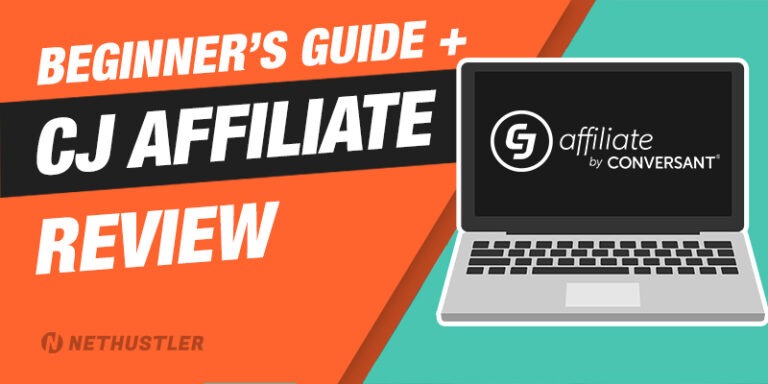
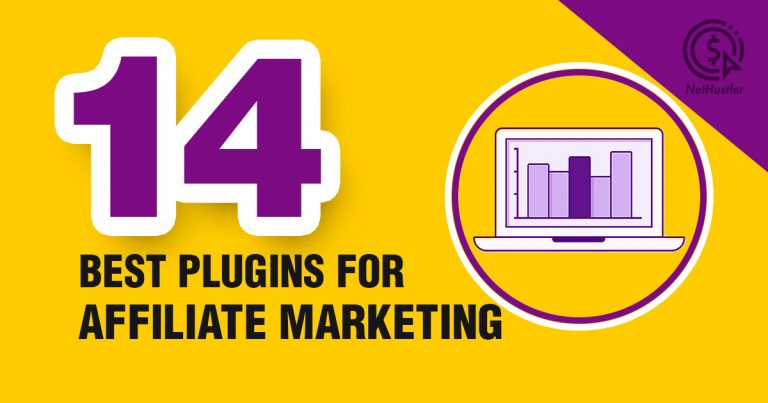
Hello Sir,
I am new to affiliate marketing, have a 7 years of experience in saas SEO, so I am sticking to this niche only.
I have 2 questions for you, please guide me:
1. Do affiliate partners allow google ads to promote their products (even if i run ads on my own blog where i have mentioned their product and put affiliate link).
2. I know a guy who has made lots of money with SaaS affiliates just by running direct ads with his affiliate link (gets banned by saas companies sometimes but still he tries with new brands), is it possible. I mean it’s unethical but is it possible?
Hi there,
Yes it is possible.
1. Every affiliate program has rules regarding promotion via Google Ads and other PPC ad networks, usually you’re not allowed to bid on their brand name for example if the product service is Semrush you’re not allowed to have keyword Semrush in your ad campaigns. But other than that you’re good to go, but again check the program rules carefully, because they will specify there the PPC rules (usually).
2. Like I said above, yes it’s possible, but make sure the affiliate program allows PPC bidding, and also be careful not to bid on their brand keyword and check the rules.
Hope this helps,
Stephen
I want set cpc is .00001 ,Google allows to me this ?
No, I don’t think you can bid lower than $0.01 on Google Ads.
Cheers,
Stephen
As someone who’s struggling to get started because I’m more interested in doing it right than blasting bullshiz out there, I appreciate you. Especially that you don’t dance around subjects, just honest and straightforward. Thank you!
Hi Vanessa, thanks, glad you enjoy my content. Wish you all the best 🙂
Stephen
Hi Stephen
Sorry, I put the wrong name (Eric) in my last comment.
No worries 🙂
This article did not teach me anything – just high-level mumbo jumbo. The real question is how you tune Google ads to give you ROI. If you knew that, you would not be writing this article. None of these youtube videos and blogs make any sense. Why don’t you try to get your money’s worth with an affiliate program when you get 4% commissions? Do you know how you can make money?
I have an article about increasing ROI on this blog, if you’re too busy to not look for it and search then I can’t help you.
Stephen,
Thanks for the informative and well-written article. This really helps me in my affiliate marketing journey.
Awesome to hear that, good luck Tom.
Thanks a lot for this detailed post. It’s been years since I’ve gotten back into the idea of paid advertising for my affiliate promotions. I’m actually in the process of launching a campaign this coming week. This article helped confirm part of my process and also gave me some tips to take consider. Much appreciated!
Hi Eric,
Thanks for reading and hope the tips help.
Cheers,
Stephen
Hi Eric
Very well written article.
I have built less than 10 Google Ads campaigns for products from different categories. I have read a lot about affiliate marketing and I know that the conversion rate is somewhere around 2%. So I didn’t have high expectations. What worries me, and maybe you can answer me, is the fact that there are many clicks from mobile phones and I think that the cookies are not registered in these devices. I know that a cookie has maximum of 30 days lifetime depending on advertiser policy. Basically, if someone doesn’t buy exactly when he click on ad, we lose the money paid for the campaign and only the advertiser is winning. Shoul I continue to improve the direct link campaigns or start creating landing pages and cetate ads for them?
Best option would be to create landing pages, collect subscribers, and promote via email. What you’re saying is indeed possible and it happens, what’s more is that if they click on your link and go to the product page and don’t buy even if they have the cookie if they then search again for that product and click through another affiliate link, someone else will get the commission, because most affiliate networks and programs work on a default “last-click attribution”, meaning the last click gets the commission.
So yeah, always go with landing pages and gather and create your own audience.
Cheers,
Stephen